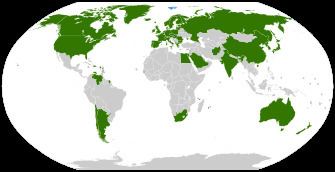Signed 9 February 1920 Effective 14 August 1925 Start date 1920 | Parties 45 | |
 | ||
Condition Ratification by all the signatory powers Depositary Government of the French Republic | ||
The Svalbard Treaty or the Spitsbergen Treaty, recognises the sovereignty of Norway over the Arctic archipelago of Svalbard, at the time called Spitsbergen. The exercise of sovereignty is, however, subject to certain stipulations, and not all Norwegian law applies. The treaty regulates the demilitarisation of the archipelago. The signatories were given equal rights to engage in commercial activities (mainly coal mining) on the islands. As of 2012, Norway and Russia are making use of this right.
Contents
Uniquely, the archipelago is an entirely visa-free zone under the terms of the Svalbard Treaty.
The treaty was signed on 9 February 1920 and submitted for registration in the League of Nations Treaty Series on 21 October 1920. There were 14 original High Contracting Parties, including: the United States, Denmark, France, Italy, Japan, the Netherlands, Norway, Sweden, and the United Kingdom of Great Britain and Ireland (including British overseas dominions of Canada, Australia, India, South Africa and New Zealand). Several additional nations signed within the next five years before the treaty came into force, including the Soviet Union in 1924 and Germany and China in 1925.
Of the original signatories, Japan was the last to ratify the treaty on 2 August 1925. On 14 August 1925, the treaty came into force. As of 2016, there are 45 parties to the treaty.
History
The archipelago was discovered by the Dutch explorer Willem Barentsz in 1596 and named Spitsbergen, meaning "sharp-peaked mountains". It was uninhabited. The islands were renamed in the 1920s by Norway as Svalbard.
Spitsbergen/Svalbard began as a territory free of a nation, with multiple people from different countries participating in industries including fishing, whaling, mining, research and later, tourism. Not belonging to any nation left Svalbard largely free of regulations or laws, though there were conflicts over the area due to whaling rights and issues of sovereignty between England, the Netherlands, and Denmark–Norway in the first half of the 17th century. However, by the 20th century mineral deposits were found on the main island and continual conflicts between miners and owners created a need for a government.
The treaty
The Spitsbergen Treaty was signed in Paris on 9 February 1920, during the Versailles negotiations after World War I. In this treaty, international diplomacy recognized Norwegian sovereignty (the Norwegian administration went in effect by 1925) and other principles relating to Svalbard. This includes:
Parties
A list of parties (sorted alphabetically) is shown below; the dates below reflect when a nation deposited its instrument of ratification or accession. Some parties are successor states to the countries that joined the treaty, as noted below.
Yugoslavia also acceded to the treaty on 6 July 1925, but as of 2016 none of its successor states have declared to continue application of the treaty.
